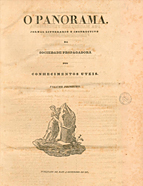

................................
In 1846, two years after the original series ended, O Panorama was revived under the initiative of typographer-editor António José Fernandes Lopes, who also launched Ilustração Luso-Brasileira . Jornal universal [Luso-Brazilian Illustration. Universal Newspaper] between 1856 and 1859. The revival aimed to recover one of the great examples of illustration in recent Portuguese periodicals while maintaining the structure of its predecessor: "This newspaper will be composed, as before, of everything that is judged to be useful in scientific discoveries, improvements in industry, and inventions in art, along with standout novelties. Despite not being strictly a newspaper, it followed the progress of the century in all its aspects" ( O Panorama , Issue 1, 3rd series, p. 2, 1846). The aim was to publish around 52 issues per year. However, when the newspaper resumed publication in September, its release was disrupted by a new conflict, the Patulean War. It was not until 1852 that O Panorama reached the desired annual number of issues and began publishing regularly and systematically thereafter. In 1858, publication was suspended. This suspension lasted until 1866, when O Panorama was revived once again (by the same typographer in collaboration with Tipografia Franco-Portuguesa [Franco-Portuguese Typography]) and continued until 1868, when the newspaper was definitively discontinued. The longevity and persistence of its publication alone indicate how reputable and admired the newspaper was. By the 1850s, O Panorama had already secured a significant place in Portuguese culture. This is evident from an "Introduction" to the Anais das Ciências e Letras [Annals of Science and Letters] in 1857, written by Rebelo da Silva (a likely disciple of Herculano) and Lopes de Mendonça: "The most admirable instrument of intellectual initiation, in the relative backwardness in which we existed, manifested its effects right away, and—written by some of the most distinguished figures of this country, whom we now have the honour of counting among our members—it perfected the language, developed a taste for letters, revived our traditions in popular imagination, and through it gave flight and impetus to those new vocations that we see gradually standing out today in all spheres of social activity" (Apud, Portuguese Intellectuals in the First Half of the 19th Century , p. 169).
This work is financed by national funds through FCT - Foundation for Science and Technology, I.P, in the scope of the projects UIDB/04311/2020 and UIDP/04311/2020.
